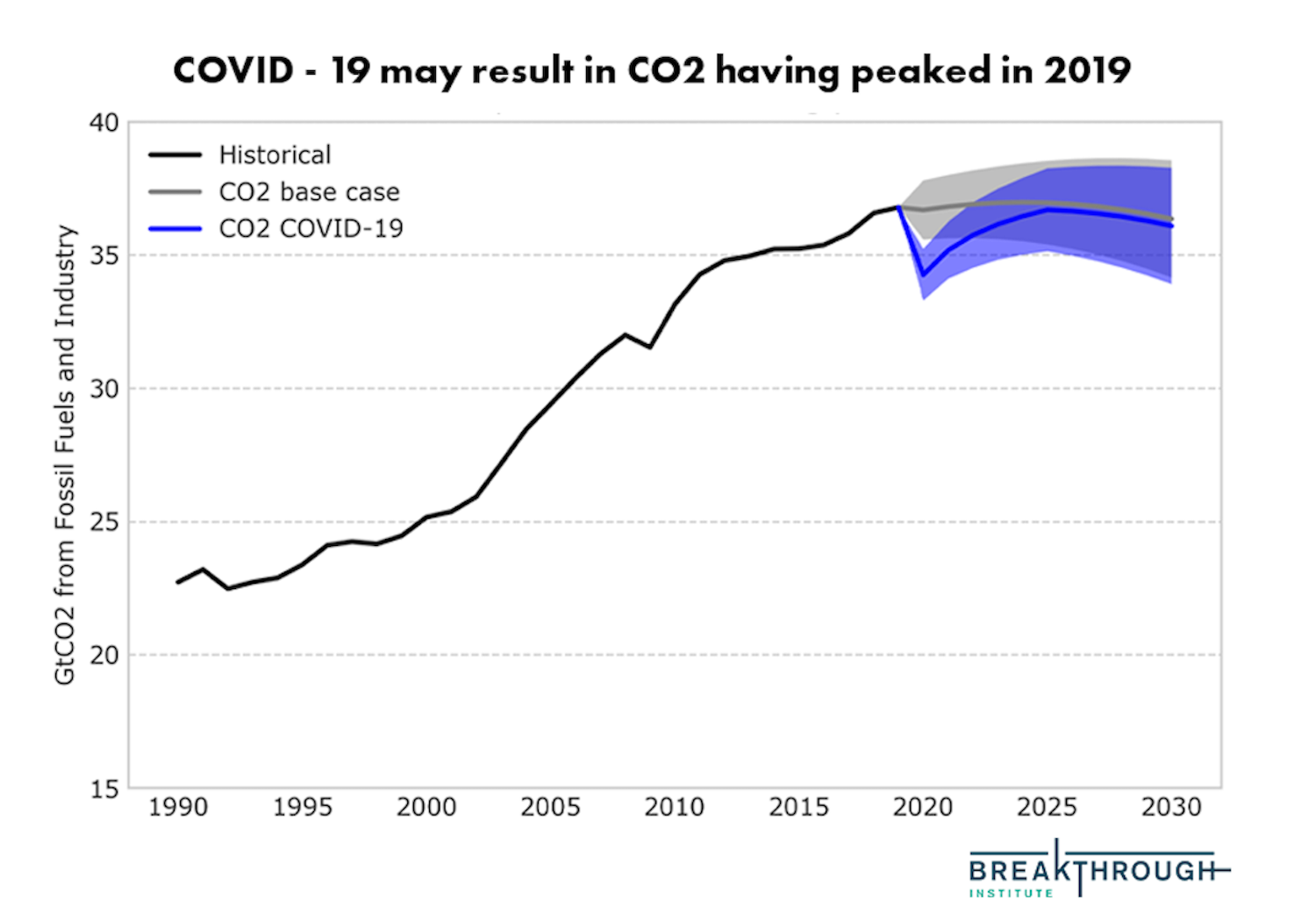CO2 Emissions from Fossil Fuels May Have Peaked in 2019
-
-
Share
-
Share via Twitter -
Share via Facebook -
Share via Email
-
In the 2000s, global CO2 emissions were increasing at an unprecedented rate. Global coal use was skyrocketing, and many predicted that emissions could triple by the end of the 21st century, ushering in truly nightmarish scenarios involving warming of 4℃ to 5℃ above pre-industrial levels by 2100.
Fast forward a decade and the world looks very different. Global coal use peaked in 2013 and is unlikely to pass that level again. Clean energy has become cost-competitive with fossil fuels for electricity generation in many countries, while the electrification of transportation and other sectors of the economy is picking up. It has become undeniable that the world is undergoing an energy transition, and it is quite possible that global CO2 emissions from fossil fuels peaked last year in 2019, based both on our own analysis and the newly released IEA World Energy Outlook (WEO) 2020.
The world is now on track for warming of around 3℃ by the year 2100 under current policies adopted by countries. This would represent a long plateau in emissions, rather than a decline. Because CO2 concentrations continue to rise as long as emissions remain much above zero, an emissions plateau is far short of the level of emissions reductions needed to limit warming to the Paris Agreement goal of 2℃ or below. But an emissions peak is an important first step, and a world of flat emissions is one where it is much more plausible to see policy helping bend down the emissions curve in the future than in a world of increasing emissions.
A race between decarbonization and growth
Emissions of CO2 represent a race between two factors: the growth of our economy, and the speed at which our economy decarbonizes. Over the past decade, the rate of decarbonization has accelerated, getting close to the rate of economic growth and leading to a substantial slowdown in the growth of emissions. If these trends continued, we would likely expect global emissions to peak in the mid-2020s. However, when the acceleration of the energy transition is combined with the shock to economic growth associated with the COVID-19 pandemic, it is quite possible that we could see a world where emissions start to decline before they recover to 2019 levels.

Structural changes associated with the COVID-19 pandemic might also play a role in speeding up the energy transition. Dropping energy demand has accelerated the decline of coal in the US and Europe, while clean energy generation has continued to grow at nearly the same rate predicted pre-pandemic. The recent announcement by China that they will reach net-zero emissions by 2060 may also play a role, as government-affiliated researchers have recently suggested that this would imply more rapid near-term emissions impacts.
The decline of coal is the single most important factor driving down future emissions projections. Most prior energy modeling efforts, such as those from the IEA WEO, had suggested a world of growing — or at best stagnant — future coal use. This year’s WEO shows a dramatically different picture, where global coal use is projected to go into structural decline for the foreseeable future.
Even more dramatic differences between projected and actual coal use can be found in the United States. The figure below shows coal electricity generation projections from the US Department of Energy EIA Annual Energy Outlook (AEO) for each year between 2010 and 2020. Coal use in 2030 is now projected to be around one-third of what models predicted back in 2010, and even this prediction may prove overly optimistic given how quickly coal use continues to fall.
A long-term plateau
The IEA has notably reduced their projection of future global FF&I CO2 emissions through 2040 in their latest WEO report. They now expect global emissions to fall by around 6.7% in 2020 compared to 2019 levels, before recovering back to around 2019 levels by 2030 and plateauing there. The figure below shows the new 2020 WEO projection (green) compared to the same scenario in last year’s report (red).
Even these latest IEA projections may be a bit conservative. The IEA has, over time, reduced their forecast of future emissions each time a new report is released, as a result of both policy developments and a history of underestimating the rate of clean energy deployment. There is no reason to think that this trend will reverse itself in the future, particularly with China’s recent net-zero commitment, which will influence short-to-medium-term energy policy in ways not included in the latest assessment.
These relatively conservative IEA projections of flat future emissions provide a stark contrast to many of the emissions scenarios underlying the climate modeling work currently being undertaken in the lead up to the 2021 Intergovernmental Panel on Climate Change (IPCC) 6th Assessment Report (AR6). The figure below shows a subset of the no mitigation and mitigation scenarios in the Shared Socioeconomic Pathways (SSPs) as colored lines, as well as the range of no policy baseline scenarios in grey. The new WEO 2020 projection is shown in green, while last year’s 2019 projection is shown by a green dashed line.

It is noteworthy that the IEA is now projecting that future emissions will be well below any of the moderate-to-no-mitigation scenarios in the SSPs. Of course, the projected long plateau is inconsistent with a scenario that limits warming to below 2℃, such as SSP1-2.6. But it also further reinforces that very-high-emission futures have become increasingly implausible as the world moves away from coal. This transition should be better reflected in the climate impacts literature, which, unfortunately, has tended to overemphasize less plausible scenarios such as RCP8.5 and its successor SSP5-8.5.


